Transmission Reduction for UV and IR Radiation with Dyed Lyocell Knitted Textiles
Abstract
1. Introduction
2. Materials and Methods
2.1. Textile
2.1.1. Textile Material Production
2.1.2. Washing Experiments
2.1.3. Abrasion Tests
2.2. Dyes and Dyeing Processes
2.2.1. Preparation of Dye Solution
2.2.2. Dyeing of Knitted Fabrics with Drimaren Yellow HF-CD
2.2.3. Dyeing of Knitted Fabrics with Solophenyl Bordeaux 3BLE
2.3. Analytics
2.3.1. Transmission Measurement
2.3.2. Calculation of Ultraviolet Protection Factor (UPF)
2.3.3. Colorimetry
3. Results
3.1. Transmission Measurement of Aqueous Dye Solutions
3.2. Transmission Spectra of Knitted Fabrics of 100% Lyocell and Lyocell with TiO2
3.3. Usability of the Dyed Knitted Fabrics
3.3.1. Washing Resistance Analysis
3.3.2. Abrasion Resistance
3.3.3. Ultraviolet Protection Factor (UPF)
4. Discussion
5. Conclusions
Author Contributions
Funding
Institutional Review Board Statement
Informed Consent Statement
Data Availability Statement
Acknowledgments
Conflicts of Interest
References
- Supe, S.; Takudage, P. Methods for evaluating penetration of drug into the skin: A review. Ski. Res. Technol. 2021, 27, 299–308. [Google Scholar] [CrossRef] [PubMed]
- Peate, I. The skin: Largest organ of the body. Br. J. Healthc. Assist. 2021, 15, 446–451. [Google Scholar] [CrossRef]
- Misery, L. How the skin reacts to environmental factors. J. Eur. Acad. Dermatol. Venerol. 2007, 21, 5–8. [Google Scholar] [CrossRef] [PubMed]
- Franco, A.C.; Aveleira, C.; Cavadas, C. Skin senescence: Mechanisms and impact on whole-body aging. Trends Mol. Med. 2022, 28, 97–109. [Google Scholar] [CrossRef]
- Silveira, J.E.P.S.; Pedroso, D.M.M. UV light and skin aging. Rev. Environ. Health 2014, 29, 243–254. [Google Scholar] [CrossRef]
- Gromkowska-Kępka, K.J.; Puścion-Jakubik, A.; Markiewicz-Żukowska, R.; Socha, K. The impact of ultraviolet radiation on skin photoaging—Review of in vitro studies. J. Cosmet. Dermatol. 2021, 20, 3427–3431. [Google Scholar] [CrossRef]
- Furukawa, J.Y.; Martinez, R.M.; Morocho-Jácome, A.L.; Castillo-Gómez, T.S.; Pereda-Contreras, V.J.; Rosado, C.; Robles Velasco, M.V.; Baby, A.R. Skin impacts from exposure to ultraviolet, visible, infrared, and artificial lights—A review. J. Cosmet. Laser Ther. 2021, 23, 1–7. [Google Scholar] [CrossRef] [PubMed]
- Diffey, B.L. Sources and measurement of ultraviolet radiation. Methods 2002, 28, 4–13. [Google Scholar] [CrossRef]
- Böttcher, H.; Mahltig, B.; Sarsour, J.; Stegmaier, T. Qualitative investigations of the photocatalytic dye destruction by TiO2-coated polyester fabrics. J. Sol-Gel Sci. Technol. 2010, 55, 177–185. [Google Scholar] [CrossRef]
- Boyes, D.H.; Evans, D.M.; Fox, R.; Parsons, M.S.; Pocock, M.J. Is light pollution driving moth population declines? A review of causal mechanisms across the life cycle. Insect Conserv. Divers. 2021, 14, 167–187. [Google Scholar] [CrossRef]
- Straka, T.M.; Wolf, M.; Gras, P.; Buchholz, S.; Voigt, C.C. Tree cover mediates the effect of artificial light on urban bats. Front. Ecol. Evol. 2019, 7, 91. [Google Scholar] [CrossRef]
- Schieke, S.M.; Schroeder, P.; Krutmann, J. Cutaneous effects of infrared radiation: From clinical observations to molecular response mechanisms. Photodermatol. Photoimmunol. Photomed. 2003, 19, 228–234. [Google Scholar] [CrossRef]
- Schröder, P.; Händeler, J.; Krutmann, J. The role of near infrared radiation in photoaging of the skin. Exp. Gerontol. 2008, 43, 629–632. [Google Scholar] [CrossRef] [PubMed]
- Müller, V.; Utikal, J.S. Sommer, Sonne, Sonnenschein—Umsicht ist geboten! Gynäkologe 2020, 53, 59–64. [Google Scholar] [CrossRef]
- Akhalaya, M.Y.; Maksimov, G.V.; Rubin, A.B.; Lademann, J.; Darvin, M.E. Molecular action mechanisms of solar infrared radiation and heat on human skin. Ageing Res. Rev. 2014, 16, 1–11. [Google Scholar] [CrossRef]
- Hoffmann, K.; Hoffmann, A.; ·Hanke, D.; Böhringer, B.; Schindling, G.; Schön, U.; Schön Klotz, M.L.; Altmeyer, P. Sonnenschutz durch optimierte Stoffe. Der Hautarzt 1998, 49, 10–16. [Google Scholar] [CrossRef] [PubMed]
- Tarbuk, A.; Grancaric, A.M.; Situm, M. Skin cancer and UV protection. Autex Res. J. 2016, 16, 19–28. [Google Scholar] [CrossRef]
- Burke, K.E.; Wie, H. Synergistic damage by UVA radiation and pollutants. Toxicol. Ind. Health 2009, 25, 219–224. [Google Scholar] [CrossRef]
- Hudson, L.; Rashdan, E.; Bonn, C.A.; Chavan, B.; Rawlings, D.; Birch-Machin, M.A. Individual and combined effects of the infrared, visible, and ultraviolet light components of solar radiation on damage biomarkers in human skin cells. FASEB J. 2020, 34, 3874–3883. [Google Scholar] [CrossRef] [PubMed]
- Lucas, R.M.; Yazar, S.; Young, A.R.; Norval, M.; De Gruijl, F.R.; Takizawa, Y.; Rhodes, L.E.; Sinclair, C.A.; Neale, R.E. Human health in relation to exposure to solar ultraviolet radiation under changing stratospheric ozone and climate. Photochem. Photobiol. Sci. 2019, 18, 641–680. [Google Scholar] [CrossRef]
- Barnes, P.W.; Williamson, C.E.; Lucas, R.M.; Robinson, S.A.; Madronich, S.; Paul, N.D.; Bornman, J.F.; Bais, A.F.; Sulzberger, B.; Wilson, S.R.; et al. Ozone depletion, ultraviolet radiation, climate change and prospects for a sustainable future. Nat. Sustain. 2019, 2, 569–579. [Google Scholar] [CrossRef]
- Bernstein, E.F.; Sarkas, H.W.; Boland, P.; Bouche, D. Beyond sun protection factor: An approach to environmental protection with novel mineral coatings in a vehicle containing a blend of skincare ingredients. J. Cosmet. Dermatol. 2020, 19, 407–415. [Google Scholar] [CrossRef]
- Mahltig, B.; Bendt, E.; Grethe, T.; Hess, O.; Weide, T.; Krieg, M. Biophysikalisches Konzept für den textilen Hautschutz. Melliand Text. 2021, 2–3, 90–92. [Google Scholar] [CrossRef]
- Bajaj, P.; Kothari, V.K.; Ghosh, S.B. Some innovations in UV protective clothing. Indian J. Fibre Text. Res. 2000, 25, 315–329. [Google Scholar]
- Qamar, M.A.; Javed, M.; Shahid, S.; Iqbal, S.; Abubshait, S.A.; Abubshait, H.A.; Ramay, S.M.; Mahmood, A.; Ghaithan, H.M. Designing of highly active g-C3N4/Co@ ZnO ternary nanocomposites for the disinfection of pathogens and degradation of the organic pollutants from wastewater under visible light. J. Environ. Chem. Eng. 2021, 9, 105534. [Google Scholar] [CrossRef]
- Sher, M.; Javed, M.; Shahid, S.; Hakami, O.; Qamar, M.A.; Iqbal, S.; Al-Anazy, M.M.; Baghdadi, H.B. Designing of highly active g-C3N4/Sn doped ZnO heterostructure as a photocatalyst for the disinfection and degradation of the organic pollutants under visible light irradiation. J. Photochem. Photobiol. A Chem. 2021, 418, 113393. [Google Scholar] [CrossRef]
- Barcelos, D.A.; Gonçalves, M.C. Daylight Photoactive TiO2 Sol-Gel Nanoparticles: Sustainable Environmental Contribution. Materials 2023, 16, 2731. [Google Scholar] [CrossRef]
- Solovyeva, M.; Selishchev, D.; Cherepanova, S.; Stepanov, G.; Zhuravlev, E.; Richter, V.; Kozlov, D. Self-cleaning photoactive cotton fabric modified with nanocrystalline TiO2 for efficient degradation of volatile organic compounds and DNA contaminants. Chem. Eng. J. 2020, 388, 124167. [Google Scholar] [CrossRef]
- Zhang, L.; Leung, M.Y.; Boriskina, S.; Tao, X. Advancing life cycle sustainability of textiles through technological innovations. Nat. Sustain. 2023, 6, 243–253. [Google Scholar] [CrossRef]
- Qian, W.; Ji, X.; Xu, P.; Wang, L. Carbon footprint and water footprint assessment of virgin and recycled polyester textiles. Textile Res. J. 2021, 91, 2468–2475. [Google Scholar] [CrossRef]
- Zhang, J.; Qian, X.; Feng, J. Review of carbon footprint assessment in textile industry. Ecofem. Clim. Chang. 2020, 1, 51–56. [Google Scholar] [CrossRef]
- Heß, O.; Korger, M.; Mahltig, B. Resource water: Reduction of water consumption during reactive dyeing of cotton. Melliand Int. 2020, 25, 134–136. [Google Scholar]
- Attia, N.F.; Osama, R.; Elashery, S.E.A.; Kalam, A.; Al-Sehemi, A.G.; Algarni, H. Recent Advances of Sustainable Textile Fabric Coatings for UV. Coatings 2022, 12, 1597. [Google Scholar] [CrossRef]
- Abd El-Hady, M.M.; Farouk, A.; El-Sayed Saeed, S.; Zaghloul, S. Antibacterial and UV Protection Properties of Modified Cotton Fabric Using a Curcumin/TiO2 Nanocomposite for Medical Textile Applications. Polymers 2021, 13, 4027. [Google Scholar] [CrossRef]
- Greiler, L.C.; Mahltig, B. Pearlescent Effect Pigments for Coatings on Textiles—Part I: Protective Materials against UV Light and IR Light. World J. Text. Eng. Technol. 2021, 7, 73–78, E-ISSN: 2415-5489/21. [Google Scholar]
- Emam, H.E.; Abdelhamid, H.N.; Abdelhameed, R.M. Self-cleaned photoluminescent viscose fabric incorporated lanthanide-organic framework (Ln-MOF). Dye. Pigment. 2018, 159, 491–498. [Google Scholar] [CrossRef]
- Mahltig, B.; Zhang, J.; Wu, L.; Darko, D.; Wendt, M.; Lempa, E.; Rabe, M.; Haase, H. Effect pigments for textile coating: A review of the broad range of advantageous functionalization. J. Coat. Technol. Res. 2017, 14, 35–55. [Google Scholar] [CrossRef]
- Mahltig, B.; Grethe, T. High-performance and functional fiber materials—A review of properties, scanning electron microscopy SEM and electron dispersive spectroscopy EDS. Textiles 2022, 2, 209–251. [Google Scholar] [CrossRef]
- Klinkhammer, K.; Ratovo, K.; Heß, O.; Bendt, B.; Grethe, T.; Krieg, M.; Sturm, M.; Weide, T.; Mahltig, B. Reduction of radiation transmission through functionalization of textiles from man-made cellulosic fibers. CDATP 2022, 3, 51–61. [Google Scholar] [CrossRef]
- Firgo, H.; Eibl, M.; Eichinger, D. Lyocell—Eine ökologische Alternative. Lenzing AG Lenzing. Ber. 1996, 75/96, 47–50. [Google Scholar]
- Erdumlu, N.; Ozipek, B. Investigation of Regenerated Bamboo Fibre and Yarn Characteristics. Fibres Text. East. Eur. 2008, 16, 43–47. [Google Scholar]
- Strauß, F. Grundlegende Aspekte der Reibechtheit von Reaktivgefärbten Cellulosematerialien. Ph.D. Thesis, Institut für Textil- und Faserchemie der Universität Stuttgart, Stuttgart, Germany, 2000; p. 11. [Google Scholar]
- Mieck, K.P.M.; Nicolai, M.; Nechwatal, A. Die Naßscheuerbeständigkeit cellulosischer Gewebe als Ausdruck der Fibrillierneigung der Faser. Lenzing. Ber. 1997, 76, 103–107. [Google Scholar]
- Schulz, F. Untersuchungen zur Beeinflussung der Fibrillierbarkeit von Lyocellfasern durch Reaktivfärbung. Ph.D. Thesis, Universität Stuttgart, Stuttgart, Germany, 1996. [Google Scholar]
- Rubeziene, V.; Padeleckiene, I.; Baltusnikaite, J.; Varnaite, S. Evaluation of Camouflage effectiveness of printed fabrics in visible and near infrared radiation spectral ranges. Mater. Sci. (Medzg.) 2008, 14, 361–365. [Google Scholar]
- Hoque, M.T.; Mahltig, B. Realisation of polyester fabrics with low transmission for ultraviolet light. Color. Technol. 2020, 136, 346–355. [Google Scholar] [CrossRef]
- Ruffen, C.; Mahltig, B. Basalt fibers as functional additives in coating of textiles. J. Coat. Technol. Res. 2021, 18, 271–281. [Google Scholar] [CrossRef]
- Kamal, M.S.; Mahmoud, E.; Hassabo, A.; Eid, M.M. Effect of some construction factors of bi-layer knitted fabrics produced for sports wear on resisting ultraviolet radiation. Egypt. J. Chem. 2020, 63, 4369–4378. [Google Scholar] [CrossRef]
- Ahmad, F.; Akhtar, K.S.; Anam, W.; Mushtaq, B.; Rasheed, A.; Ahmad, S.; Azam, F.; Nawab, Y. Recent Developments in Materials and Manufacturing Techniques Used for Sports Textiles. Int. J. Polym. Sci. 2023, 2023, 2021622. [Google Scholar] [CrossRef]
- Scott, R. Textile in Defence. In Handbook of Technical Textiles; Horrocks, A.R., Anand, S.C., Eds.; Woodhead Publishing Limited: Cambridge, UK, 2000; p. 560. [Google Scholar]
- Mahltig, B.; Böttcher, H.; Rauch, K.; Dieckmann, U.; Nitsche, R.; Fritz, T. Optimized UV protecting coatings by combination of organic and inorganic UV absorbers. Thin Solid Film. 2005, 485, 108–114. [Google Scholar] [CrossRef]
- Sk, M.S.; Akram, W.; Mia, R.; Fang, J.; Shekh Kabir, S.M.M. Fabrication of UV-Protective Polyester Fabric with Polysorbate 20 Incorporating Fluorescent Color. Polymers 2022, 14, 4366. [Google Scholar] [CrossRef]
- Lenzing, A.G. Ultraviolet Protective Fabrics Based on Man-Made Cellulosic Fibres. EP 2443275B1, 29 June 2016. [Google Scholar]
- Zollinger, H. Color Chemistry, 2nd ed.; VCH: Weinheim, Germany, 1991. [Google Scholar]
- Berneth, H. Farbstoffe—Eine Übersicht; Bayer AG: Leverkusen, Germany, 2001; p. 56. [Google Scholar]
- Burkinshaw, S.M. The role of inorganic electrolyte (salt) in cellulosic fibre dyeing: Part 1 fundamental aspects. Color. Technol. 2021, 137, 421–444. [Google Scholar] [CrossRef]
- Benkhaya, S.; M’rabet, S.; El Harfi, A. A review on classifications, recent synthesis and applications of textile dyes. Inorg. Chem. Commun. 2020, 115, 107891. [Google Scholar] [CrossRef]
- Peter, M.; Rouette, H.K. Grundlagen der Textilveredlung—Handbuch der Technologie, Verfahren, Maschinen, 13; Aufl., Deutscher Fachverlag: Frankfurt am Main, Germany, 1989; p. 140. [Google Scholar]
- Müller, W. (Ed.) Handbuch der Farbenchemie; Ecomed Verlagsgesellschaft: Landsberg am Lech, Germany, 2000; Volume 4, pp. 5–7. [Google Scholar]
- Kent, J. Handbook of Industrial Chemistry and Biotechnology vol.1, 11th ed.; Springer Science+Business Media LLC: New York, NY, USA, 2007; p. 512. [Google Scholar]
- Rouette, H.K.; Fischer-Bobsien, C.H. Lexikon für Textilveredlung Band 1; Laumann Verlag: Dülmen, Germany, 1995; pp. 405–407. [Google Scholar]
- Wardman, R.H. An Introduction to Textile Coloration, Society of Dyers and Colorists; John Wiley and Sons Ltd.: Chichester, UK, 2018. [Google Scholar]
- Koslowski, H.J. Chemiefaserlexikon; Deutscher Fachverlag: Frankfurt am Main, Germany, 1997. [Google Scholar]
- Meyer zur Capellen, T. Lexikon der Gewebe; Deutscher Fachverlag: Frankfurt am Main, Germany, 2015. [Google Scholar]
- AS/NZ S4 399; Australian/New Zealand Standard, Sunprotectiveclothing—Evaluation and Classification. Standards Australia: Homebush, Australia; Standards New Zealand: Wellington, New Zealand, 1996.
- Kim, Y.K. Ultraviolet Protection Finishes for Textiles. In Functional Finishes for Textiles; Paul, R., Ed.; Woodhead Publishing: Cambridge, UK, 2015; pp. 463–485. [Google Scholar]
- Seilnacht, T. Pigmente und Bindemittel; Seilnacht Verlag & Atelier: Bern, Switzerland, 2018. [Google Scholar]
- Lübbe, E. Farbempfindung, Farbbeschreibung und Farbmessung; Springer Vieweg: Wiesbaden, Germany, 2013. [Google Scholar]
- Gorjanc, M.; Sala, M. Durable Antibacterial and UV Protective Properties of Cellulose Fabric Functionalized with Ag/TiO2 Nanocomposites during Dyeing with Reactive Dyes; Springer Science+Business Media: Dorderecht, The Netherlands, 2016. [Google Scholar]
- Paluszkiewicz, J.; Czajkowski, W.; Kaźmierska, M.; Stolarski, R. Reactive Dyes for Cellulose Fibres including UV Absorber. Fibres Text. East. Eur. 2005, 13, 76–80. [Google Scholar]
- BASF Ratgeber Cellulosefaser—Schlichten, Vorbehandeln, Färben; BASF Aktien Gesellschaft: Ludwigshafen, Germany, 1977; p. 287.
- Czajkowski, W.; Paluszkiewicz, J. Synthesis of bifunctional monochlortriazine reactive dyes increasing UV-protection properties of cotton fabrics. Fibers Text. East. Eur. 2008, 16, 122–126. [Google Scholar]
- Mahltig, B.; Leisegang, T.; Jakubik, M.; Haufe, H. Hybrid sol-gel materials for realization of radiation protective coatings—A review with emphasis on UV protective materials. J. Sol-Gel Sci. Technol. 2021, 1–12. [Google Scholar] [CrossRef]
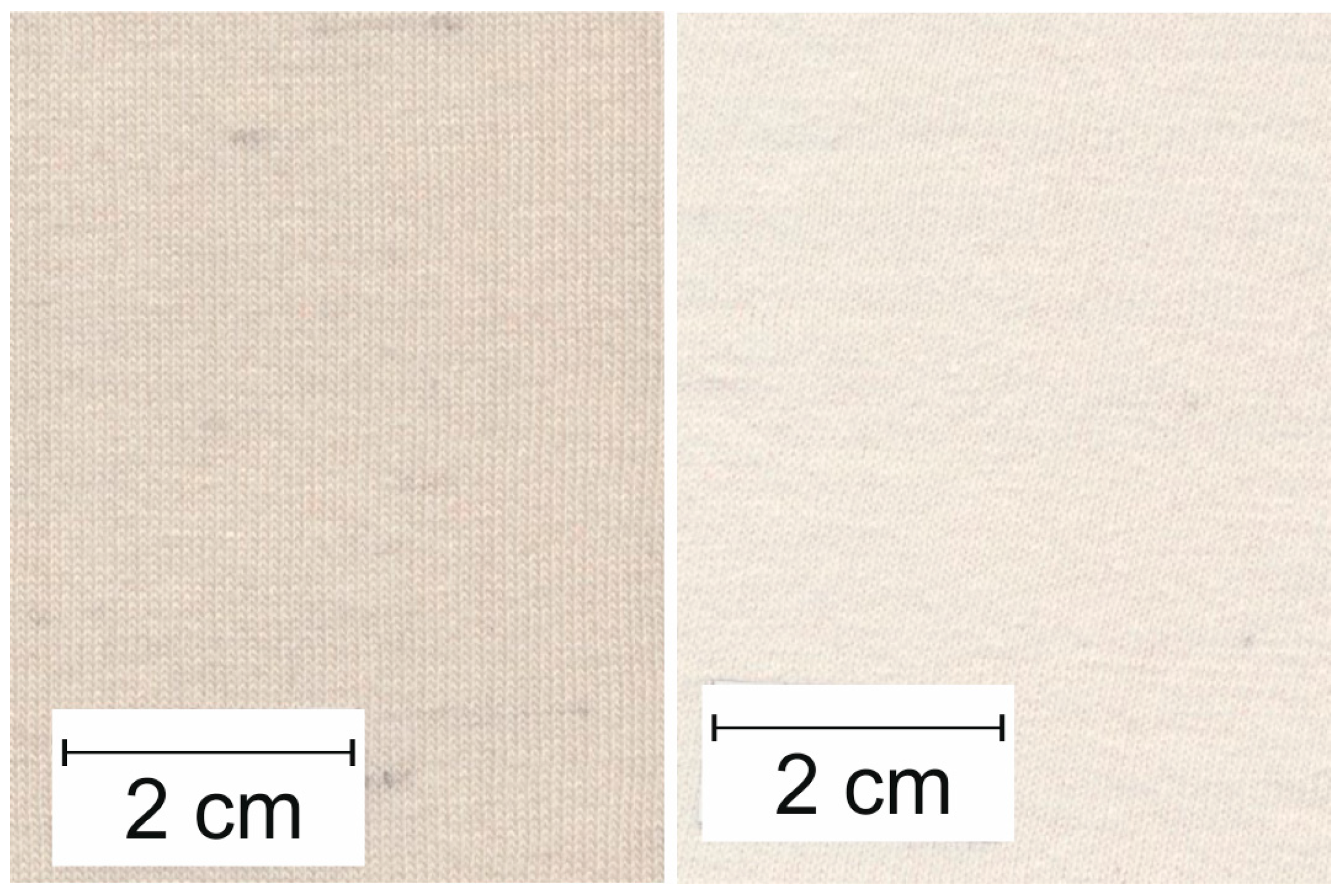
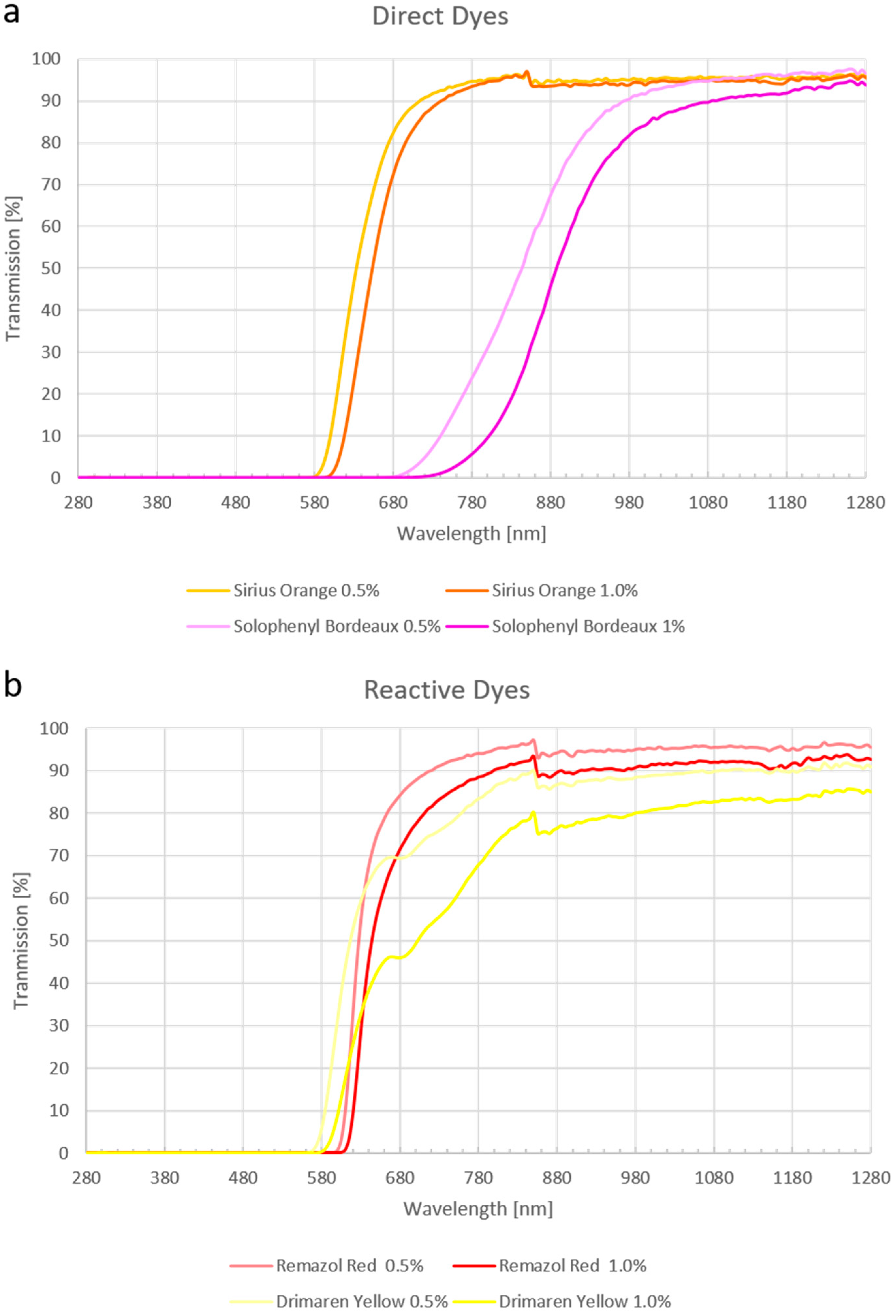
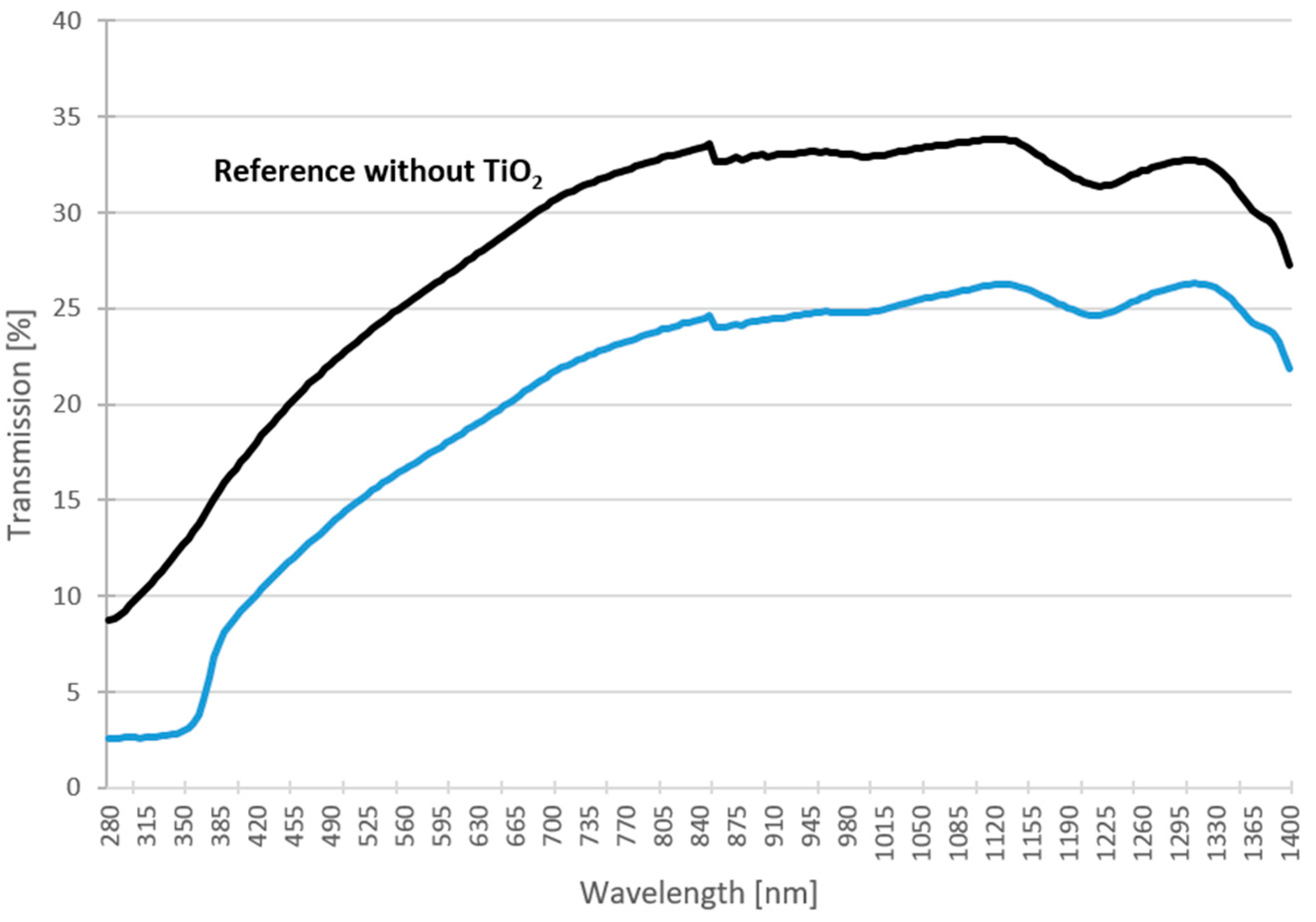
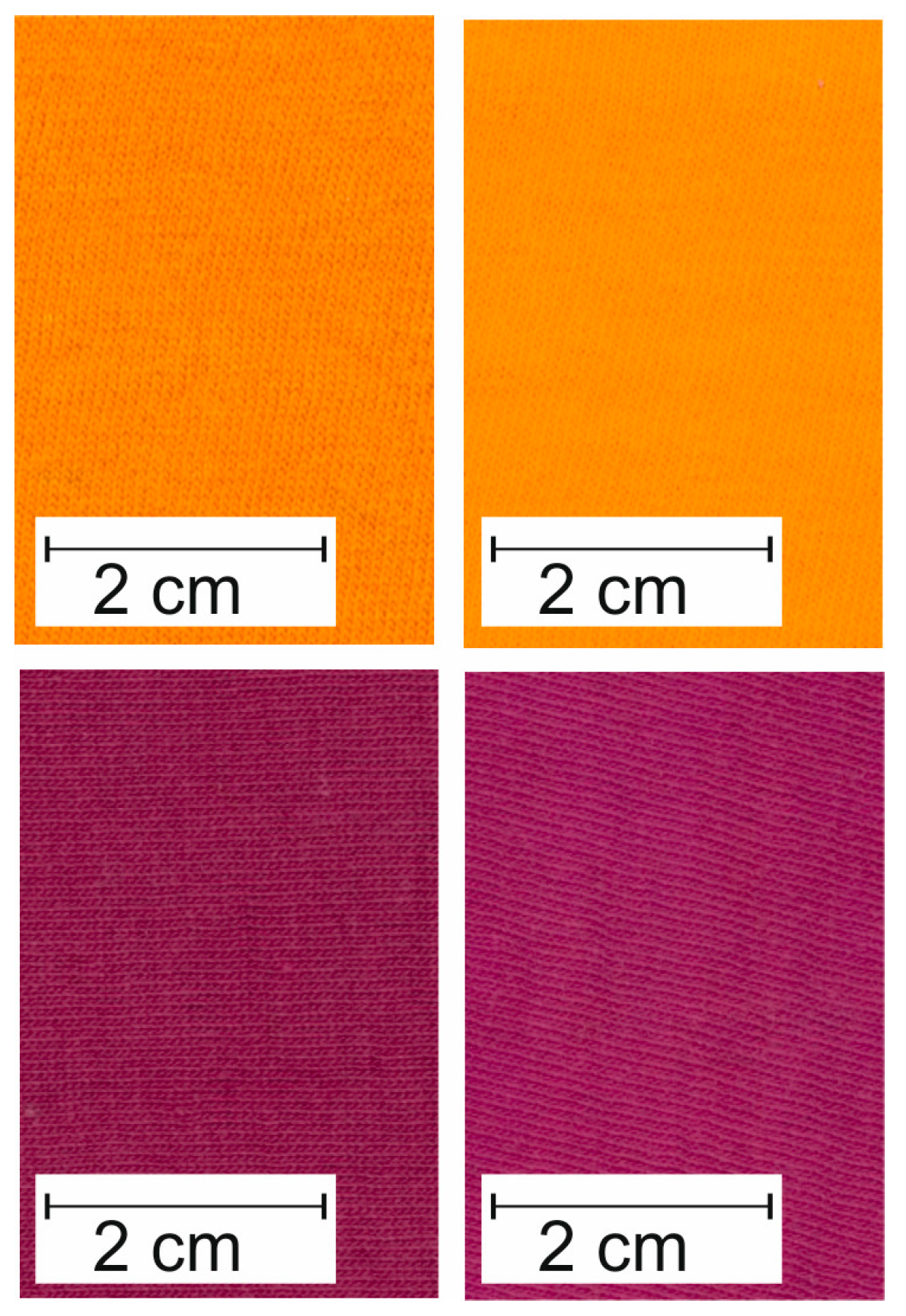

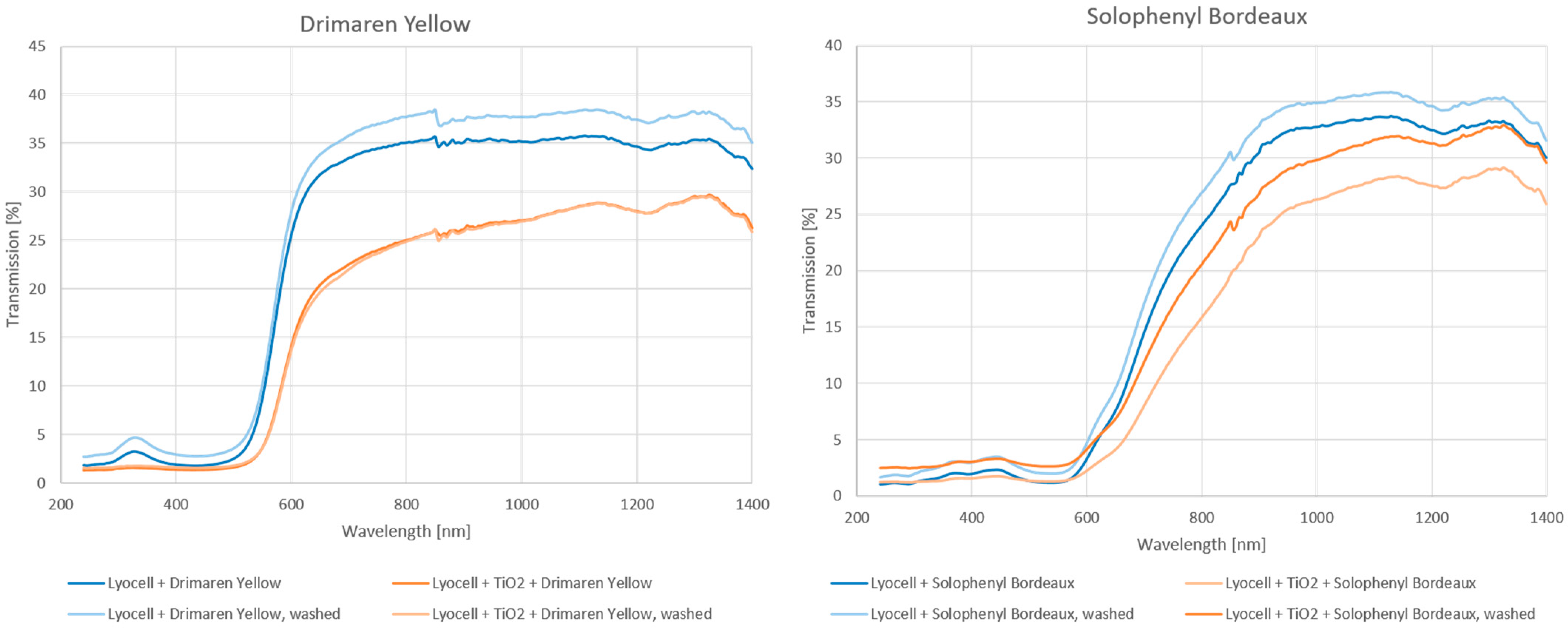

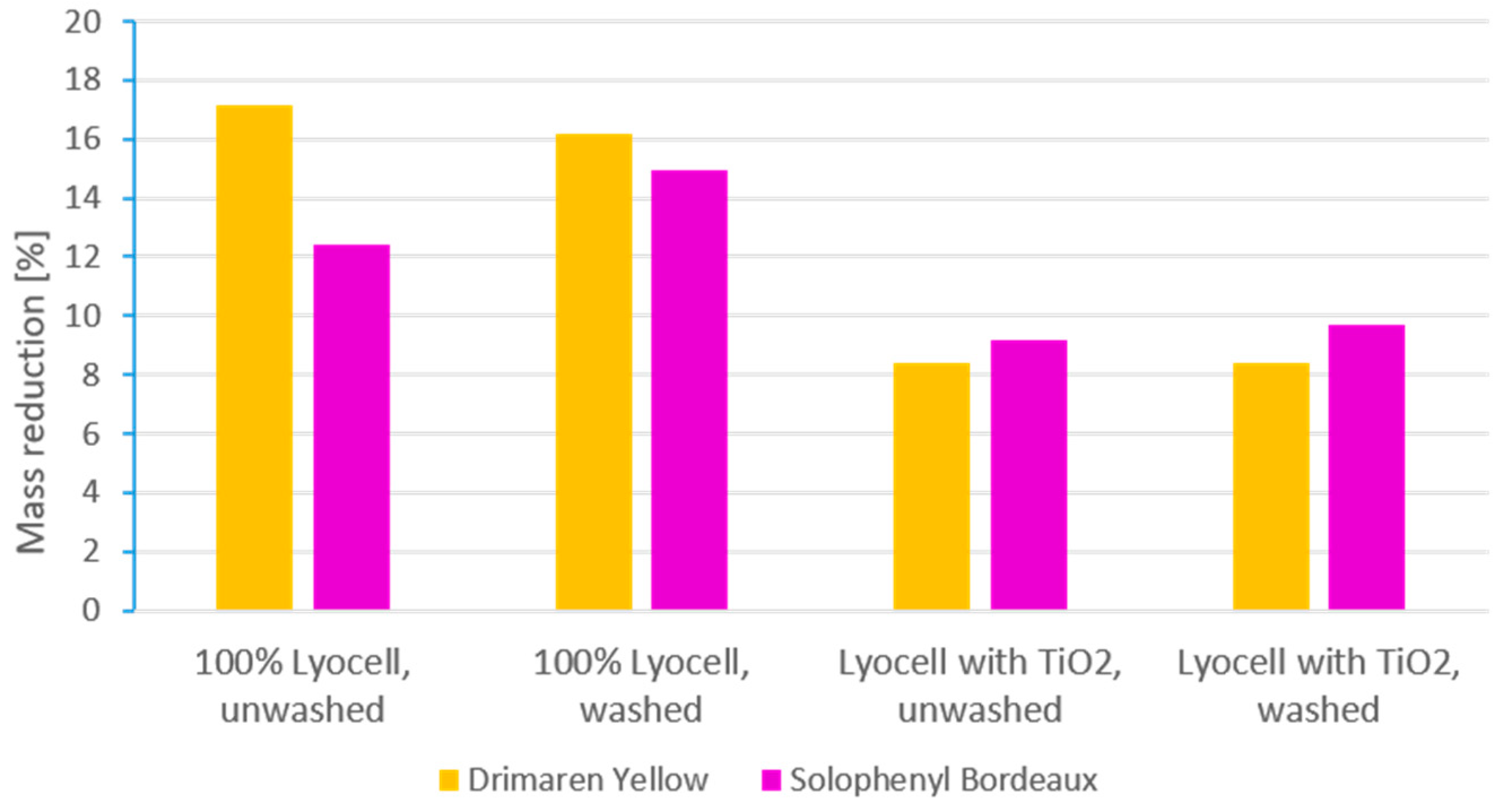
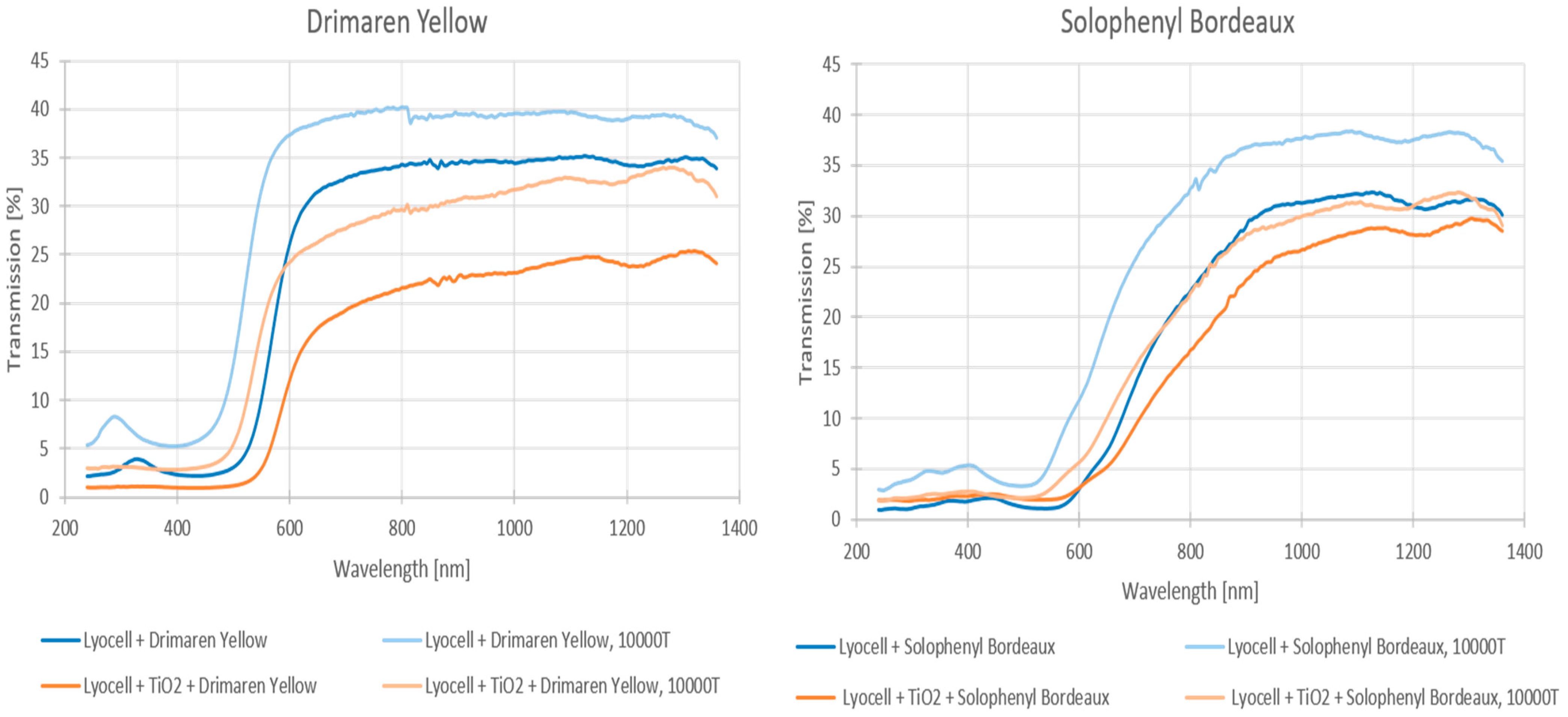
| UPF Range | UVR Protection Category |
|---|---|
| <15 | bad |
| 15–24 | good protection |
| 25–39 | very good protection |
| 40–50, 50+ | excellent protection |
| Sample | L* | a* | b* | C* | h |
|---|---|---|---|---|---|
| 100% Lyocell, undyed | 84.36 | 1.23 | 6.33 | 6.45 | 79.01 |
| Lyocell with TiO2, undyed | 90.99 | 1.31 | 4.74 | 4.92 | 74.57 |
| 100% Lyocell, Drimaren Yellow, unwashed | 59.93 | 34.51 | 63.72 | 72.47 | 61.56 |
| 100% Lyocell, Drimaren Yellow, washed | 59.57 | 34.82 | 63.02 | 72.00 | 61.08 |
| Lyocell with TiO2, Drimaren Yellow, unwashed | 64.80 | 35.01 | 67.77 | 76.28 | 62.60 |
| Lyocell with TiO2, Drimaren Yellow, washed | 63.03 | 35.71 | 64.37 | 73.61 | 60.98 |
| 100% Lyocell, Solophenyl Bordeaux, unwashed | 33.89 | 29.70 | −3.39 | 29.89 | 353.49 |
| 100% Lyocell, Solophenyl Bordeaux, washed | 36.22 | 28.95 | −3.79 | 29.19 | 352.53 |
| Lyocell with TiO2, Solophenyl Bordeaux, unwashed | 34.57 | 34.43 | −6.11 | 34.96 | 349.94 |
| Lyocell with TiO2, Solophenyl Bordeaux, washed | 35.99 | 33.41 | −6.48 | 34.03 | 349.02 |
| Sample | ΔE* | ΔL* | Δa* | Δb* |
|---|---|---|---|---|
| Solophenyl Bordeaux, 100% Lyocell | 2.48 | 2.33 | −0.75 | −0.41 |
| Solophenyl Bordeaux Lyocell with TiO2 | 1.79 | 1.43 | −1.01 | −0.38 |
| Drimaren Yellow, 100% Lyocell | 0.85 | −0.36 | 0.31 | −0.70 |
| Drimaren Yellow, Lyocell with TiO2 | 3.90 | −1.77 | 0.70 | −3.40 |
| Sample | UPF | UVR Protection Category (See Table 1) |
|---|---|---|
| 100% Lyocell | 6 | bad |
| Lyocell with TiO2 | 43 | excellent |
| 100% Lyocell, Drimaren Yellow | 40 | excellent |
| 100% Lyocell, Drimaren Yellow, washed | 27 | very good |
| Lyocell with TiO2, Drimaren Yellow | 69 | excellent |
| Lyocell with TiO2, Drimaren Yellow, washed | 59 | excellent |
| 100% Lyocell, Solophenyl Bordeaux | 67 | excellent |
| 100% Lyocell, Solophenyl Bordeaux, washed | 42 | excellent |
| Lyocell with TiO2, Solophenyl Bordeaux | 73 | excellent |
| Lyocell with TiO2, Solophenyl Bordeaux, washed | 37 | very good |
Disclaimer/Publisher’s Note: The statements, opinions and data contained in all publications are solely those of the individual author(s) and contributor(s) and not of MDPI and/or the editor(s). MDPI and/or the editor(s) disclaim responsibility for any injury to people or property resulting from any ideas, methods, instructions or products referred to in the content. |
© 2023 by the authors. Licensee MDPI, Basel, Switzerland. This article is an open access article distributed under the terms and conditions of the Creative Commons Attribution (CC BY) license (https://creativecommons.org/licenses/by/4.0/).
Share and Cite
Klinkhammer, K.; Weskott, P.; Ratovo, K.; Krieg, M.; Bendt, E.; Mahltig, B. Transmission Reduction for UV and IR Radiation with Dyed Lyocell Knitted Textiles. Appl. Sci. 2023, 13, 5432. https://doi.org/10.3390/app13095432
Klinkhammer K, Weskott P, Ratovo K, Krieg M, Bendt E, Mahltig B. Transmission Reduction for UV and IR Radiation with Dyed Lyocell Knitted Textiles. Applied Sciences. 2023; 13(9):5432. https://doi.org/10.3390/app13095432
Chicago/Turabian StyleKlinkhammer, Kristina, Phillip Weskott, Karin Ratovo, Marcus Krieg, Ellen Bendt, and Boris Mahltig. 2023. "Transmission Reduction for UV and IR Radiation with Dyed Lyocell Knitted Textiles" Applied Sciences 13, no. 9: 5432. https://doi.org/10.3390/app13095432
APA StyleKlinkhammer, K., Weskott, P., Ratovo, K., Krieg, M., Bendt, E., & Mahltig, B. (2023). Transmission Reduction for UV and IR Radiation with Dyed Lyocell Knitted Textiles. Applied Sciences, 13(9), 5432. https://doi.org/10.3390/app13095432







